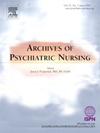Self-neglect, anxiety and depression among empty nesters in China: A network analysis
IF 2.2
4区 医学
Q1 NURSING
引用次数: 0
Abstract
Previous studies have shown that anxiety and depression are important factors affecting self-neglect among empty nesters and are a prerequisite for the occurrence of self-neglect. However, there is still little data on the potential mechanism of influence between anxiety, depression and self-neglect. This study aimed to construct a network structure to investigate the connections between self-neglect, anxiety and depression in Chinese empty nesters, identifying core and bridge symptoms in the network and analyze the mechanisms that influence their connection. We analyzed data from 4985 empty nesters aged 60 and above in the CLHLS 2017–2018. Questionnaire items were selected to assess self-neglect, while depression and anxiety were measured using the CESD-10 and GAD-7 scales. Network analysis was conducted using R software to explore the relationships between self-neglect, anxiety, and depression. Network analysis identified central nodes (e.g., GAD2, CESD3) and bridge nodes (e.g., SN1, GAD1, CESD1) that link self-neglect, anxiety, and depression symptoms. Central symptoms (e.g., uncontrollable worry, felt sadness) and key bridge symptoms (e.g., lifestyle, nervousness or anxiety, bother by things) could serve as intervention targets for empty nesters experiencing self-neglect, anxiety, and depression.
中国空巢老人的自我忽视、焦虑和抑郁:一个网络分析
以往的研究表明,焦虑和抑郁是影响空巢老人自我忽视的重要因素,是自我忽视发生的先决条件。然而,关于焦虑、抑郁和自我忽视之间的潜在影响机制的数据仍然很少。本研究旨在构建一个网络结构,探讨中国空巢老人自我忽视、焦虑和抑郁之间的联系,识别网络中的核心症状和桥梁症状,并分析其联系的影响机制。我们分析了2017-2018年CLHLS中4985名60岁及以上空巢老人的数据。选择问卷项目评估自我忽视,使用csd -10和GAD-7量表测量抑郁和焦虑。利用R软件进行网络分析,探讨自我忽视与焦虑、抑郁之间的关系。网络分析确定了连接自我忽视、焦虑和抑郁症状的中心节点(如GAD2、CESD3)和桥节点(如SN1、GAD1、CESD1)。中心症状(例如,无法控制的担忧,感到悲伤)和关键桥梁症状(例如,生活方式,紧张或焦虑,被事物困扰)可以作为自我忽视,焦虑和抑郁的空巢老人的干预目标。
本文章由计算机程序翻译,如有差异,请以英文原文为准。
求助全文
约1分钟内获得全文
求助全文
来源期刊
CiteScore
3.70
自引率
0.00%
发文量
131
审稿时长
160 days
期刊介绍:
Archives of Psychiatric Nursing disseminates original, peer-reviewed research that is of interest to psychiatric and mental health care nurses. The field is considered in its broadest perspective, including theory, practice and research applications related to all ages, special populations, settings, and interdisciplinary collaborations in both the public and private sectors. Through critical study, expositions, and review of practice, Archives of Psychiatric Nursing is a medium for clinical scholarship to provide theoretical linkages among diverse areas of practice.

 求助内容:
求助内容: 应助结果提醒方式:
应助结果提醒方式:


